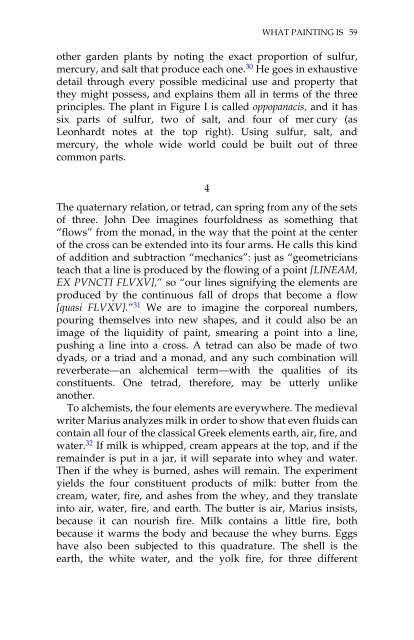What Painting Is: How to Think about Oil Painting ... - Victoria Vesna
What Painting Is: How to Think about Oil Painting ... - Victoria Vesna
What Painting Is: How to Think about Oil Painting ... - Victoria Vesna
You also want an ePaper? Increase the reach of your titles
YUMPU automatically turns print PDFs into web optimized ePapers that Google loves.
WHAT PAINTING IS 59<br />
other garden plants by noting the exact proportion of sulfur,<br />
mercury, and salt that produce each one. 30 He goes in exhaustive<br />
detail through every possible medicinal use and property that<br />
they might possess, and explains them all in terms of the three<br />
principles. The plant in Figure I is called oppopanacis, and it has<br />
six parts of sulfur, two of salt, and four of mer cury (as<br />
Leonhardt notes at the <strong>to</strong>p right). Using sulfur, salt, and<br />
mercury, the whole wide world could be built out of three<br />
common parts.<br />
4<br />
The quaternary relation, or tetrad, can spring from any of the sets<br />
of three. John Dee imagines fourfoldness as something that<br />
“flows” from the monad, in the way that the point at the center<br />
of the cross can be extended in<strong>to</strong> its four arms. He calls this kind<br />
of addition and subtraction “mechanics”: just as “geometricians<br />
teach that a line is produced by the flowing of a point [LINEAM,<br />
EX PVNCTI FLVXV],” so “our lines signifying the elements are<br />
produced by the continuous fall of drops that become a flow<br />
[quasi FLVXV].” 31 We are <strong>to</strong> imagine the corporeal numbers,<br />
pouring themselves in<strong>to</strong> new shapes, and it could also be an<br />
image of the liquidity of paint, smearing a point in<strong>to</strong> a line,<br />
pushing a line in<strong>to</strong> a cross. A tetrad can also be made of two<br />
dyads, or a triad and a monad, and any such combination will<br />
reverberate—an alchemical term—with the qualities of its<br />
constituents. One tetrad, therefore, may be utterly unlike<br />
another.<br />
To alchemists, the four elements are everywhere. The medieval<br />
writer Marius analyzes milk in order <strong>to</strong> show that even fluids can<br />
contain all four of the classical Greek elements earth, air, fire, and<br />
water. 32 If milk is whipped, cream appears at the <strong>to</strong>p, and if the<br />
remainder is put in a jar, it will separate in<strong>to</strong> whey and water.<br />
Then if the whey is burned, ashes will remain. The experiment<br />
yields the four constituent products of milk: butter from the<br />
cream, water, fire, and ashes from the whey, and they translate<br />
in<strong>to</strong> air, water, fire, and earth. The butter is air, Marius insists,<br />
because it can nourish fire. Milk contains a little fire, both<br />
because it warms the body and because the whey burns. Eggs<br />
have also been subjected <strong>to</strong> this quadrature. The shell is the<br />
earth, the white water, and the yolk fire, for three different


